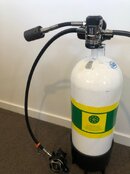Does anyone have a link to the hose and the spool? Would like to make sure I get the correct ones....I have the Shearwater Perdix AI on the way
What JimBlay linked there is all you need.
I got the same 'shoulder design' viton air spool with the metal separator in the middle rather than a simple tube, and a Scubapro kevlar HP hose in 10cm/4in. The hp hose length is your main decision point. Some people go for a minimum 15cm hose and perhaps Miflex, but I don't want it to flop around or require being tied to another hose, just enough to not be grabbed by people and get out of the way of a fully inflated wing.
The spool spare in the SAD kit is a good idea.
Steps
1. Take O ring off the transmitter
2. Insert one end of the air spool into the transmitter (make sure you have no other flow restrictor installed in the transmitter of course)
3. Screw the transmitter onto the hose and gently tighten with two wrenches (to hand tight, but it's better than twisting the plastic housing of the trans).
It definitely felt off with the squished exposed O ring, but it's not something I wanted to just remove without confirming, so thanks once again for everyone's help.
Attached is a picture from pressure/IP testing after, 10.5l tank for scale (maybe called LP85 in your neck). The trans can still move 2cm in either direction but otherwise holds itself there when pressurised. When diving I usually tilt the 1st stage slightly so that the inflator hose pokes up a bit and the transmitter tucks away behind the wing rather than straight out the side. It's an inverted MK17 so the trans coming out the top is extra dicey otherwise.






